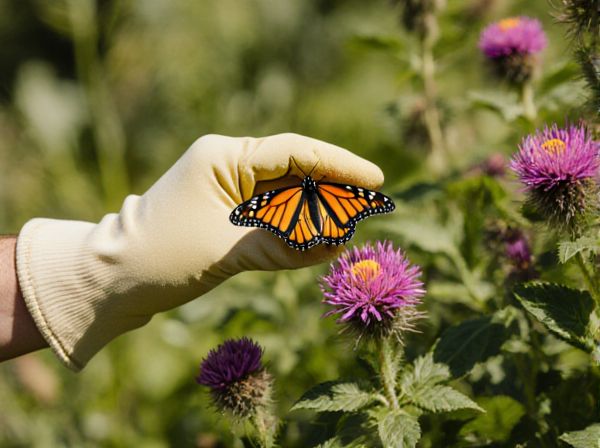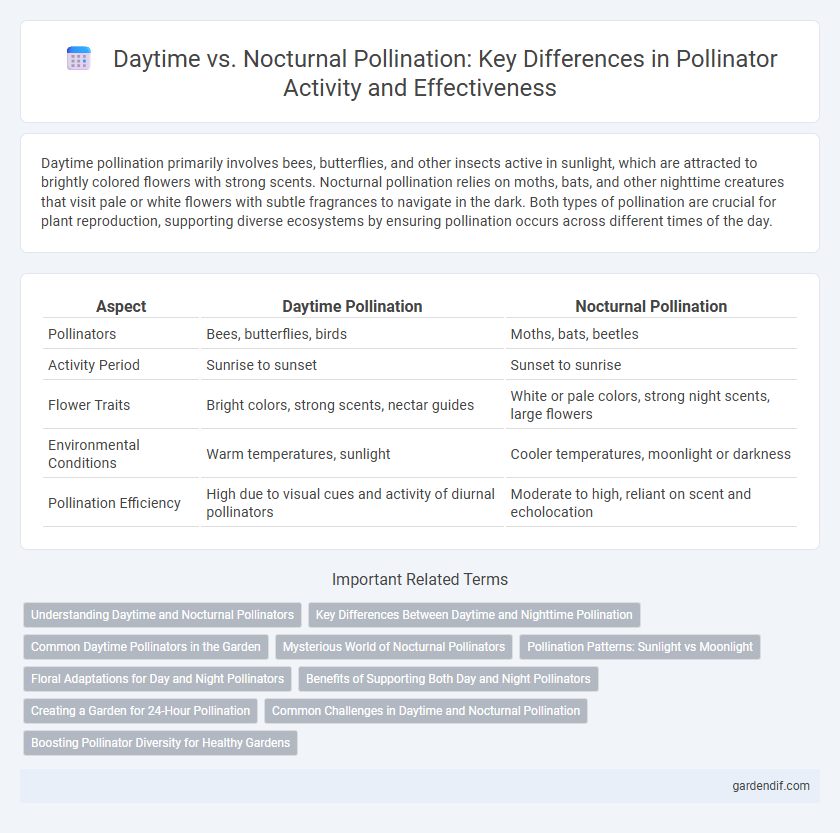
Daytime Pollination vs Nocturnal Pollination Illustration
Daytime pollination primarily involves bees, butterflies, and other insects active in sunlight, which are attracted to brightly colored flowers with strong scents. Nocturnal pollination relies on moths, bats, and other nighttime creatures that visit pale or white flowers with subtle fragrances to navigate in the dark. Both types of pollination are crucial for plant reproduction, supporting diverse ecosystems by ensuring pollination occurs across different times of the day.
Table of Comparison
| Aspect | Daytime Pollination | Nocturnal Pollination |
|---|---|---|
| Pollinators | Bees, butterflies, birds | Moths, bats, beetles |
| Activity Period | Sunrise to sunset | Sunset to sunrise |
| Flower Traits | Bright colors, strong scents, nectar guides | White or pale colors, strong night scents, large flowers |
| Environmental Conditions | Warm temperatures, sunlight | Cooler temperatures, moonlight or darkness |
| Pollination Efficiency | High due to visual cues and activity of diurnal pollinators | Moderate to high, reliant on scent and echolocation |
Understanding Daytime and Nocturnal Pollinators
Daytime pollination primarily involves bees, butterflies, and birds, which are attracted to brightly colored flowers and rely on visual cues and nectar rewards. Nocturnal pollination is often carried out by moths, bats, and some beetles, which are adapted to detect scent and use echolocation or other sensory mechanisms to locate flowers in low light conditions. Understanding the distinct behaviors and sensory adaptations of these pollinators is crucial for preserving biodiversity and ensuring effective pollination across different ecosystems.
Key Differences Between Daytime and Nighttime Pollination
Daytime pollination primarily involves diurnal insects like bees and butterflies, which are attracted to brightly colored flowers with strong scents that open during the day. Nocturnal pollination relies on moths, bats, and other night-active animals drawn to pale or white flowers emitting sweet fragrances at night. Key differences include the timing of floral scent release, flower color adaptations, and the distinct visual or olfactory cues optimized for either daylight or darkness to maximize pollination efficiency.
Common Daytime Pollinators in the Garden
Bees, butterflies, and hoverflies are the most common daytime pollinators in the garden, actively transferring pollen from flower to flower during daylight hours. These insects are attracted to brightly colored flowers rich in nectar, facilitating efficient pollination of various garden plants. Daytime pollination supports the growth of fruits, vegetables, and flowers, contributing significantly to garden biodiversity and productivity.
Mysterious World of Nocturnal Pollinators
Nocturnal pollinators, such as moths, bats, and certain beetles, play a crucial role in maintaining biodiversity by pollinating night-blooming flowers that rely on moonlight and subtle floral scents. Unlike daytime pollinators like bees and butterflies, nocturnal species navigate through darkness using heightened sensory adaptations, including echolocation and enhanced olfactory receptors. These pollinators contribute significantly to ecosystem health, supporting plant reproduction and genetic diversity in nighttime environments.
Pollination Patterns: Sunlight vs Moonlight
Daytime pollination predominantly relies on sunlight, attracting diurnal pollinators such as bees and butterflies that navigate using visual cues and UV patterns on flowers. Nocturnal pollination, in contrast, occurs under moonlight and involves moths, bats, and other night-active species that depend more on olfactory signals and flower scents than on visual stimuli. These differing pollination patterns influenced by sunlight and moonlight shape the evolution of floral traits and pollinator behaviors in various ecosystems.
Floral Adaptations for Day and Night Pollinators
Flowers adapted for daytime pollination often exhibit bright colors and strong scents to attract diurnal pollinators such as bees and butterflies, with ultraviolet patterns guiding these insects to nectar sources. In contrast, nocturnal pollination relies on pale or white flowers that reflect moonlight and emit potent fragrances to lure moths and bats, animals that navigate through scent and low-light vision. Floral morphology may also change, with some plants opening their blooms only at night to synchronize with their nocturnal pollinators' activity patterns.
Benefits of Supporting Both Day and Night Pollinators
Supporting both daytime and nocturnal pollinators enhances biodiversity by ensuring continuous pollination across different plant species that bloom during various times. Daytime pollinators like bees and butterflies are efficient at transferring pollen under sunlight, while nocturnal pollinators such as moths and bats facilitate pollination of night-blooming flowers, increasing overall ecosystem resilience. This dual support promotes stable crop yields and natural habitat health by maximizing pollination opportunities throughout a 24-hour cycle.
Creating a Garden for 24-Hour Pollination
Creating a garden that supports 24-hour pollination requires integrating diverse plant species that attract both daytime and nocturnal pollinators. Brightly colored flowers with strong scents appeal to bees, butterflies, and hummingbirds active during the day, while pale or white blossoms emitting night fragrances attract moths, bats, and other nocturnal pollinators. Incorporating a mix of bloom times and habitat features like water sources and sheltered areas ensures continuous pollinator activity, enhancing biodiversity and garden productivity.
Common Challenges in Daytime and Nocturnal Pollination
Daytime pollination faces challenges such as higher temperatures that can cause flower desiccation and increased exposure to predators that affect pollinator activity. Nocturnal pollination encounters obstacles including limited visibility for pollinators and cooler temperatures that can slow pollinator metabolism and movement. Both pollination types must navigate environmental factors and floral adaptations that influence pollinator efficiency and reproductive success.
Boosting Pollinator Diversity for Healthy Gardens
Daytime pollination primarily involves bees, butterflies, and other diurnal insects that enhance pollinator diversity by targeting flowers open during daylight hours, ensuring robust fruit and seed production. Nocturnal pollinators, such as moths and bats, complement this by visiting night-blooming plants, expanding the range of pollinated species. Promoting both daytime and nocturnal pollination supports a balanced ecosystem and increases garden resilience against environmental stressors.
Daytime Pollination vs Nocturnal Pollination Infographic

 gardendif.com
gardendif.com